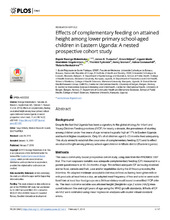| dc.contributor.author | Malembaka, Espoir Bwenge | en_US |
| dc.contributor.author | Tumwine, James K | en_US |
| dc.contributor.author | Ndeezi, Grace | en_US |
| dc.contributor.author | Engebretsen, Ingunn Marie S. | en_US |
| dc.contributor.author | Tylleskär, Thorkild | en_US |
| dc.contributor.author | Wamani, Henry | en_US |
| dc.contributor.author | Sommerfelt, Halvor | en_US |
| dc.contributor.author | Nankabirwa, Victoria | en_US |
| dc.date.accessioned | 2020-08-04T13:22:40Z | |
| dc.date.available | 2020-08-04T13:22:40Z | |
| dc.date.issued | 2019-02-07 | |
| dc.Published | Malembaka, Tumwine JK, Ndeezi G, Engebretsen IMS, Tylleskär T, Wamani H, Sommerfelt H, Nankabirwa V. Effects of complementary feeding on attained height among lower primary school-aged children in Eastern Uganda: A nested prospective cohort study. PLOS ONE. 2019;14(2):e0211411 | eng |
| dc.identifier.issn | 1932-6203 | |
| dc.identifier.uri | https://hdl.handle.net/1956/23414 | |
| dc.description.abstract | Background: Despite the fact that Uganda has been a signatory to the global strategy for Infant and Young Children Feeding practices (IYCF) for nearly a decade, the prevalence of stunting among children under five years of age remains tragically high at 17% in Eastern Uganda and twofold higher countrywide. Only 6% of all children aged 6–23 months feed adequately. This study aimed to establish the covariates of complementary feeding (CF) and its effect on attained height among primary school-aged children in Mbale district (Eastern Uganda). Methods: This was a community-based prospective cohort study using data from the PROMISE EBF trial. The main exposure variable was adequate complementary feeding (CF) measured in a parent questionnaire at 18–24 months of age. We defined adequate CF as having received animal food, cereals and fruit, juice and/or vegetables during the 24 hours preceding the interview. An adapted minimum acceptable diet was defined as having been given milk or milk products at least twice a day, an adapted meal frequency of two and solid or semi-solid food from at least four food groups on a 24-hour dietary recall based on modified IYCF criteria. The main outcome variable was attained height [(height-for-age Z score (HAZ)] measured between five and eight years of age using the WHO growth standards. Effects of CF on HAZ were estimated using linear regression analyses with cluster-robust standard errors. Results: A total of 506 children were studied. The majority (85%) were from rural areas and the average age at the end of the study was 6.9 (standard deviation: 0.63) years. Of these, 23.9% were adequately fed and 2.3% received the adapted minimum acceptable diet. Adequate CF was not associated with HAZ (adjusted β = -0.111; 95% CI: -0.363, 0.141; p = 0.374). Factors significantly associated with attained height were baseline HAZ (0.262; 0.152, 0.374; p<0.001) and WHZ (-0.147; -0.243, -0.051; p = 0.004), child’s age (0.454; -0.592, -0.315; p<0.001) and maternal education (0.030; 95% CI: 0.003, 0.057; p = 0.034). Conclusion: Adequate CF at age 18–24 months was worryingly insufficient and not associated with attained HAZ at age 5–8 years. Further strategies need to be considered to improve child nutrition and linear growth in resource-constrained settings. | en_US |
| dc.language.iso | eng | eng |
| dc.publisher | PLoS | eng |
| dc.rights | Attribution CC BY | eng |
| dc.rights.uri | http://creativecommons.org/licenses/by/4.0/ | eng |
| dc.title | Effects of complementary feeding on attained height among lower primary school-aged children in Eastern Uganda: A nested prospective cohort study | en_US |
| dc.type | Peer reviewed | |
| dc.type | Journal article | |
| dc.date.updated | 2019-12-23T09:41:02Z | |
| dc.description.version | publishedVersion | en_US |
| dc.rights.holder | Copyright 2019 The Authors | |
| dc.identifier.doi | https://doi.org/10.1371/journal.pone.0211411 | |
| dc.identifier.cristin | 1713163 | |
| dc.source.journal | PLoS ONE | |

